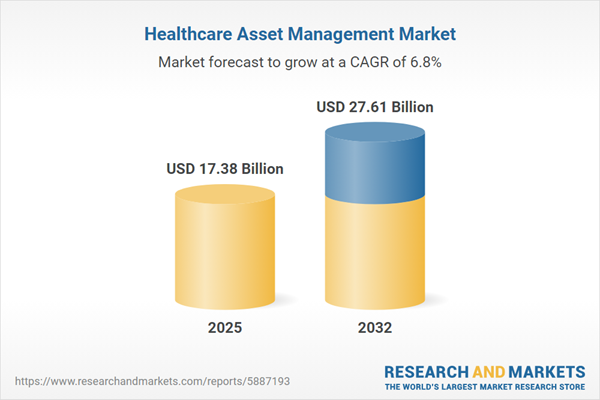Speak directly to the analyst to clarify any post sales queries you may have.
The healthcare asset management market is evolving rapidly as organizations adapt to complex regulatory, operational, and technological demands. Improving resource utilization and risk management remains at the forefront, guiding procurement and operational decisions for providers striving for both efficiency and exemplary patient outcomes.
Market Snapshot: Healthcare Asset Management Market Growth and Trends
The Healthcare Asset Management Market advanced from USD 16.25 billion in 2024 to USD 17.38 billion in 2025 and is projected to achieve a CAGR of 6.84%, reaching USD 27.61 billion by 2032. This steady trajectory reflects sector-wide investments in intelligent asset tracking, digital transformation, and strategies designed to control costs and comply with emerging regulatory mandates. The ongoing integration of Internet of Things (IoT) solutions, predictive analytics, and mobile platforms is reshaping the way healthcare providers maintain operations, optimize equipment, and elevate care standards.
Scope & Segmentation
This report provides an in-depth analysis of the healthcare asset management landscape across technologies, solutions, and geographies. Segmentation is as follows:
- Medical Equipment: Imaging equipment (Computed Tomography Scanners, Magnetic Resonance Imaging Machines), patient monitoring systems, general and minimally invasive surgical instruments
- Information Technology Infrastructure: Hardware (networking equipment, servers), software (analytics, asset management platforms), and associated services
- Facilities Management: Building automation (HVAC systems, lighting control), housekeeping, security systems (access control, surveillance)
- Pharmaceuticals: Biopharmaceuticals (monoclonal antibodies, recombinant proteins), branded drugs (cardiovascular, oncology), generic drugs
- Laboratory Instruments: Analytical (chromatography, spectroscopy), life science instruments (cell analysis, PCR systems)
- Regions Covered: Americas (including United States, Canada, Mexico, Brazil, Argentina, Chile, Colombia, Peru), Europe, Middle East & Africa (including United Kingdom, Germany, France, Russia, Italy, Spain, Netherlands, Sweden, Poland, Switzerland, United Arab Emirates, Saudi Arabia, Qatar, Turkey, Israel, South Africa, Nigeria, Egypt, Kenya), Asia-Pacific (including China, India, Japan, Australia, South Korea, Indonesia, Thailand, Malaysia, Singapore, Taiwan)
- Key Companies Profiled: GE HealthCare Technologies Inc., Koninklijke Philips N.V., Siemens Healthineers AG, McKesson Corporation, Cardinal Health Inc., Baxter International Inc., Abbott Laboratories, Oracle Corporation, Accruent LLC, International Business Machines Corporation
Key Takeaways
- Asset management in healthcare now encompasses preventative maintenance, real-time monitoring, and compliance validation, offering a holistic approach to equipment lifecycle management.
- Deployment of integrated digital platforms speeds transition from reactive to proactive asset strategies, directly supporting both operational efficiency and patient safety objectives.
- IoT connectivity, machine learning, and predictive analytics are driving operational shifts, providing actionable insights to both technical and clinical teams for improved care delivery.
- Cross-functional collaboration between clinical engineers, IT specialists, and administrative leaders is crucial to reconcile diverse priorities and ensure streamlined asset management processes.
- Value-based care models incentivize alignment of asset utilization with measurable patient outcome improvements, linking technology investments more closely to care quality and resource sustainability.
Tariff Impact: U.S. Tariff Adjustments and Supply Chain Strategies
Recent U.S. tariff policies have led to rising costs for imported medical devices, IT hardware, and pharmaceuticals, prompting a shift toward renegotiation of vendor contracts and increased consideration of domestic or regional sourcing. This has sparked organizational moves toward local manufacturing partnerships, group purchasing, and consolidated procurement frameworks to mitigate cost volatility and maintain resilient supply chains.
Primary Keyword: Healthcare Asset Management Market
Methodology & Data Sources
This study combines primary interviews with clinical engineers, procurement leaders, and technology experts, supported by structured surveys capturing digital adoption and operational best practices. Secondary sources include regulatory publications, corporate white papers, industry journals, and financial disclosures. Rigorous triangulation of qualitative and quantitative data ensures reliable, actionable insights for stakeholders.
Why This Report Matters
- Delivers actionable intelligence to optimize asset utilization, streamline procurement, and improve regulatory compliance across healthcare settings.
- Enables hospital and provider leadership to benchmark asset management maturity, prioritize investments, and drive operational standardization.
- Empowers executive teams with insights on technology trends, supply chain vulnerabilities, and competitive positioning to support strategic planning.
Conclusion
The healthcare asset management market is shaped by digital innovations, regulatory shifts, and new sourcing strategies, all converging to enhance operational resilience and patient care standards. Effective implementation of integrated asset management paves the way for sustained performance and future-readiness in healthcare organizations.
Additional Product Information:
- Purchase of this report includes 1 year online access with quarterly updates.
- This report can be updated on request. Please contact our Customer Experience team using the Ask a Question widget on our website.
Table of Contents
3. Executive Summary
4. Market Overview
7. Cumulative Impact of Artificial Intelligence 2025
Companies Mentioned
The companies profiled in this Healthcare Asset Management market report include:- GE HealthCare Technologies Inc.
- Koninklijke Philips N.V.
- Siemens Healthineers AG
- McKesson Corporation
- Cardinal Health, Inc.
- Baxter International Inc.
- Abbott Laboratories
- Oracle Corporation
- Accruent, LLC
- International Business Machines Corporation
Table Information
| Report Attribute | Details |
|---|---|
| No. of Pages | 199 |
| Published | October 2025 |
| Forecast Period | 2025 - 2032 |
| Estimated Market Value ( USD | $ 17.38 Billion |
| Forecasted Market Value ( USD | $ 27.61 Billion |
| Compound Annual Growth Rate | 6.8% |
| Regions Covered | Global |
| No. of Companies Mentioned | 11 |









